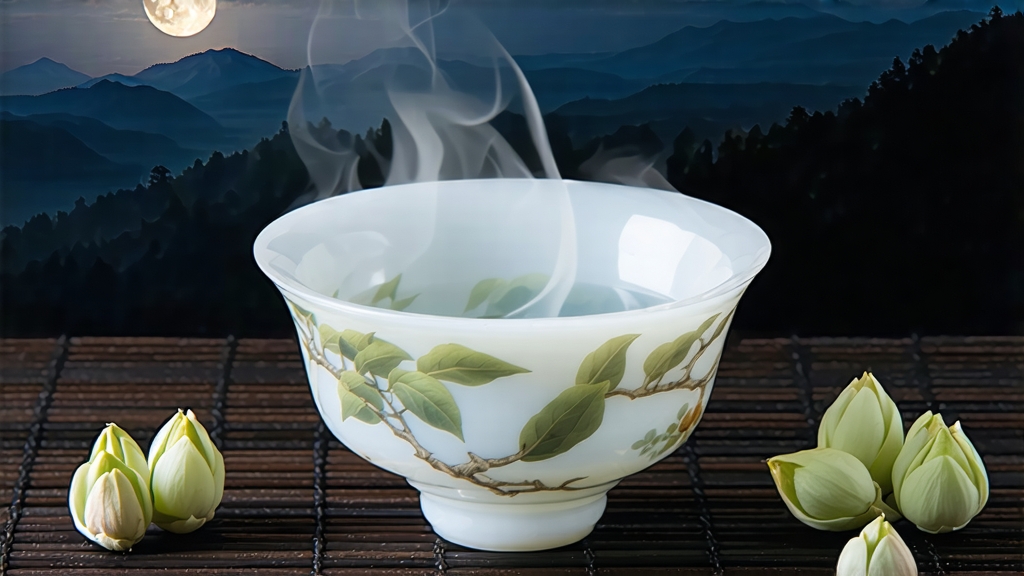
Tucked high on the forested ridges of Yunnan’s Simao and Lincang prefectures, a tea that the locals call Yue Guang Bai—“White Moonlight”—is harvested while the rest of China sleeps. Pickers rise at 1 a.m., guided only by the waxing moon and the rhythmic drone of cicadas. By dawn the baskets are already on the back of motorbikes, racing downhill so that the leaves can “bathe in moonlight” one more night before the sun claims them. To the outside world the practice sounds romantic; to the farmers it is pragmatic insurance against Yunnan’s fierce ultraviolet rays, which can redden tender buds and flatten the delicate, orchid-like fragrance that connoisseurs prize. Yet romance and pragmatism have always danced together in the story of white tea, and White Moonlight may be their most graceful choreography.
Although white tea as a category was canonized in Fujian during the late Qing dynasty—Silver Needle, White Peony, Gong Mei, Shou Mei—Yue Guang Bai is a relative newcomer, barely three decades old. Oral history credits a small Bulang-village producer who, in the mid-1990s, found himself with a surplus of Jinggu Da Bai cultivar intended for pu-erh maocha. Unwilling to waste the buds, he spread them on bamboo trays inside his stilt house, allowing the high-elevation night breeze to wither them for forty-eight hours. The resulting liquor, pale champagne with a silvery meniscus, tasted unlike anything in the white-tea canon: brighter than White Peony, rounder than Silver Needle, with a lingering note of wild honey that reminded drinkers of moonlight itself. Word spread along the Tea-Horse Road; soon Kunming merchants were coining the poetic name, and by 2010 Yue Guang Bai had become a cult favorite among specialty cafés from Berlin to Melbourne.
Botanically the tea belongs to the broad-leaf Assamica variety, not the small-leaf Sinensis used in Fujian. This genetic difference is critical: Assamica buds are chunkier, laden with polyphenols and long-chain amino acids that translate into a creamier body. Farmers select only the “one bud, one leaf” pluck in early March, just before the Qingming festival, when the plant’s L-theanine peak coincides with cooler nights. The elevation—between 1,600 and 1,900 m—slows metabolic activity, allowing fragrant terpenes to accumulate while catechins remain moderate, yielding a naturally sweet cup without the grassy astringency that can plague lower-grown whites.
Processing is disarmingly simple yet obsessively timed. After nocturnal picking, the leaves rest in shallow bamboo sieves under open skylights. Because Yunnan’s March air humidity hovers around 65%, moisture evaporates gradually; oxidases activate just enough to round the edges, but the absence of direct sunlight keeps enzymatic browning in check. At dawn the trays are carried indoors to a loft whose walls are lined with mosquito netting; here the tea “dreams” for another 18–24 h while the moon sets and the mountain temperature drops to 8°C. The cold snap fixes the pale celadon color and locks in a precursor molecule that cuppers describe as “night-blooming jasmine.” Finally, the leaves pass through a low-temperature dehydrator set to 38°C for twenty minutes—hot enough to halt oxidation, cool enough to preserve the fuzzy trichomes that sparkle like frost. No rolling, no roasting, no charcoal scent: just the whispered alchemy of time, altitude, and lunar photons.
Because the leaf is fluffed rather than compressed, it is extremely light: 3 g can fill a 150 ml gaiwan to the brim. The classic Yunnanese brewing ritual therefore favors restraint. Begin by rinsing the porcelain with 85°C spring water; this preheats the vessel and tames the residual mountain chill. Add the leaves, shake gently, and inhale—the dry aroma should suggest fresh lychee peel and wet limestone. The first infusion, 30 s at 80°C, releases a liquor the color of brushed pewter; raise the cup to a window and you will notice a faint opalescent ring, what poets call “the moon’s fingerprint.” Sip with teeth slightly parted; the tea will arc across the palate, depositing a cool, almost mentholated sensation at the back of the throat. Inf